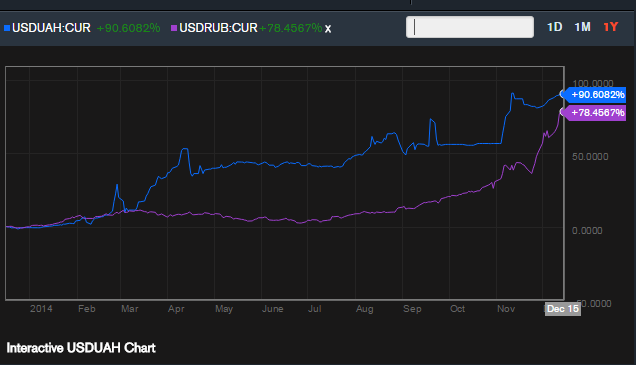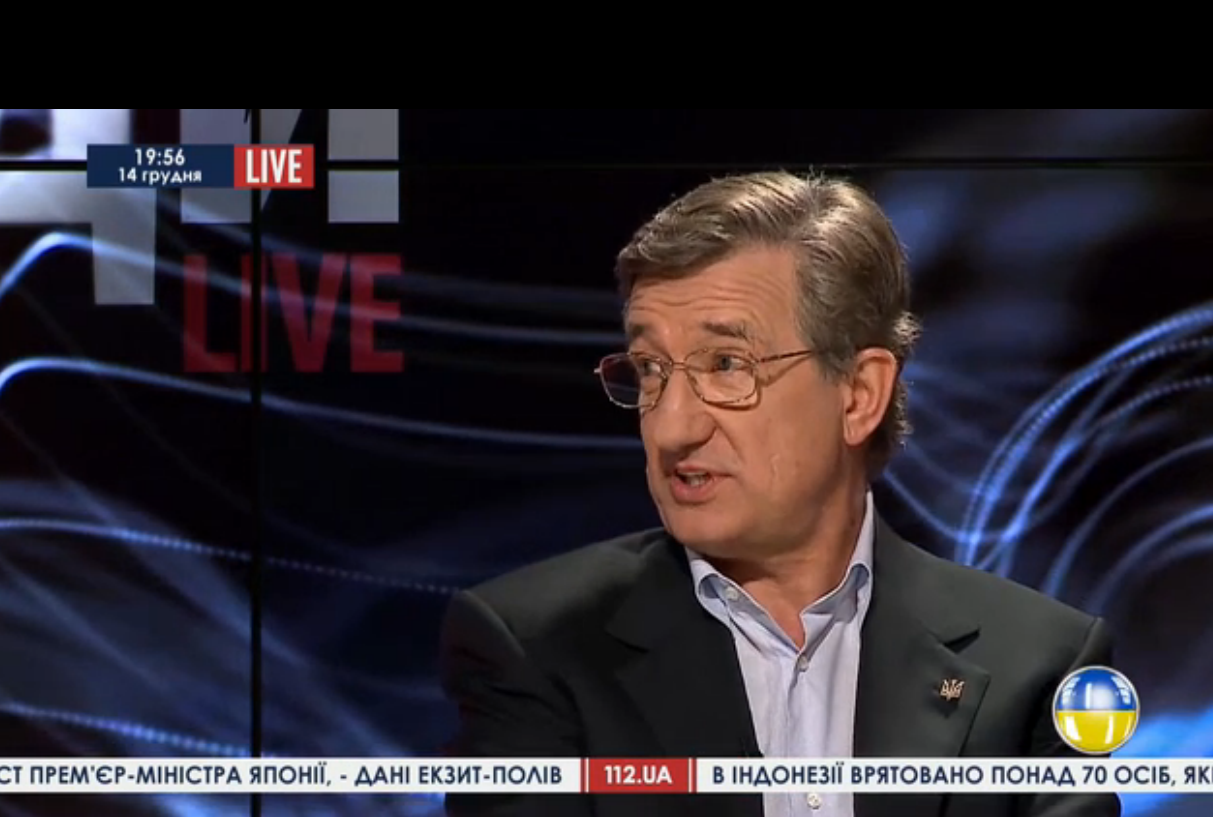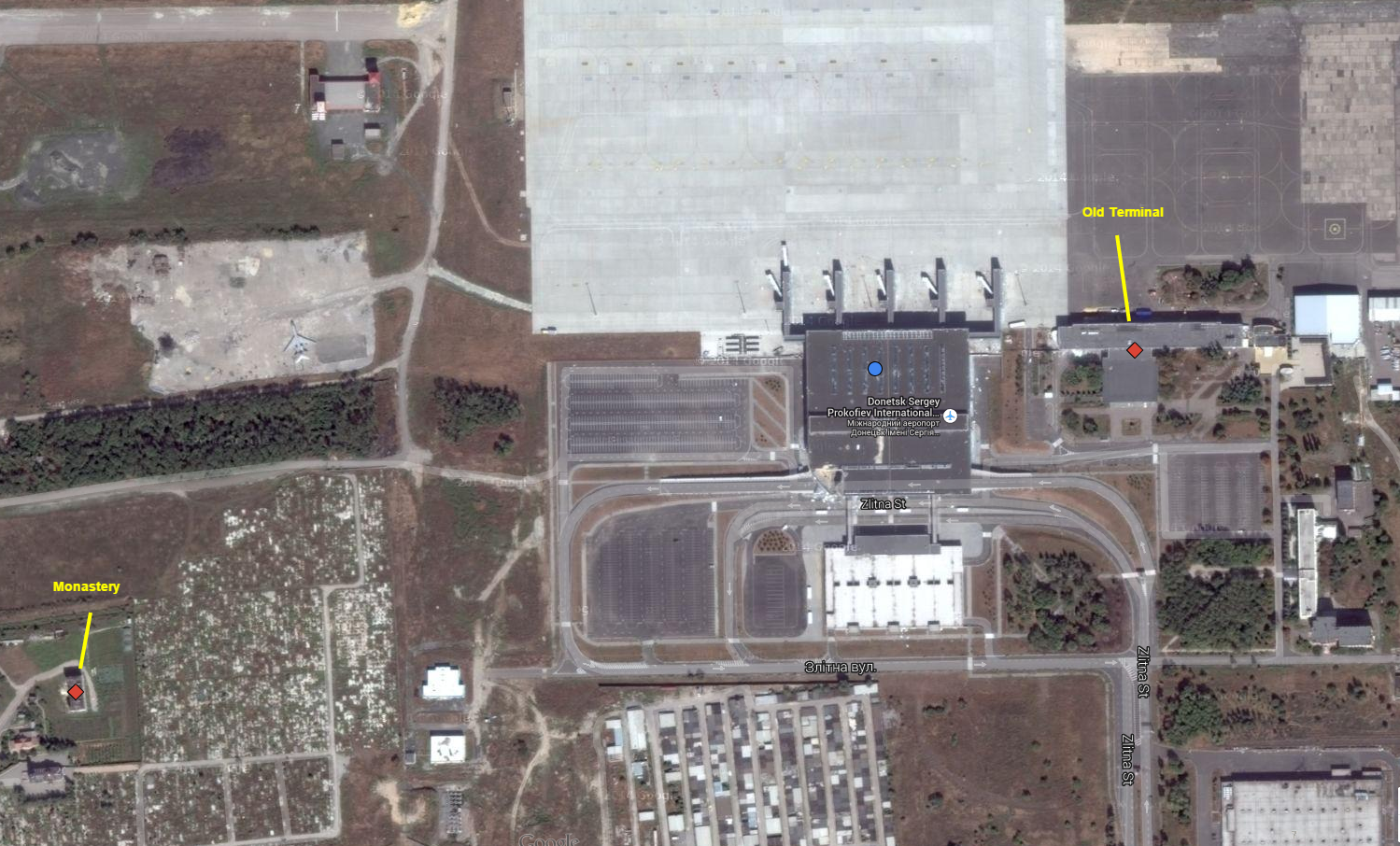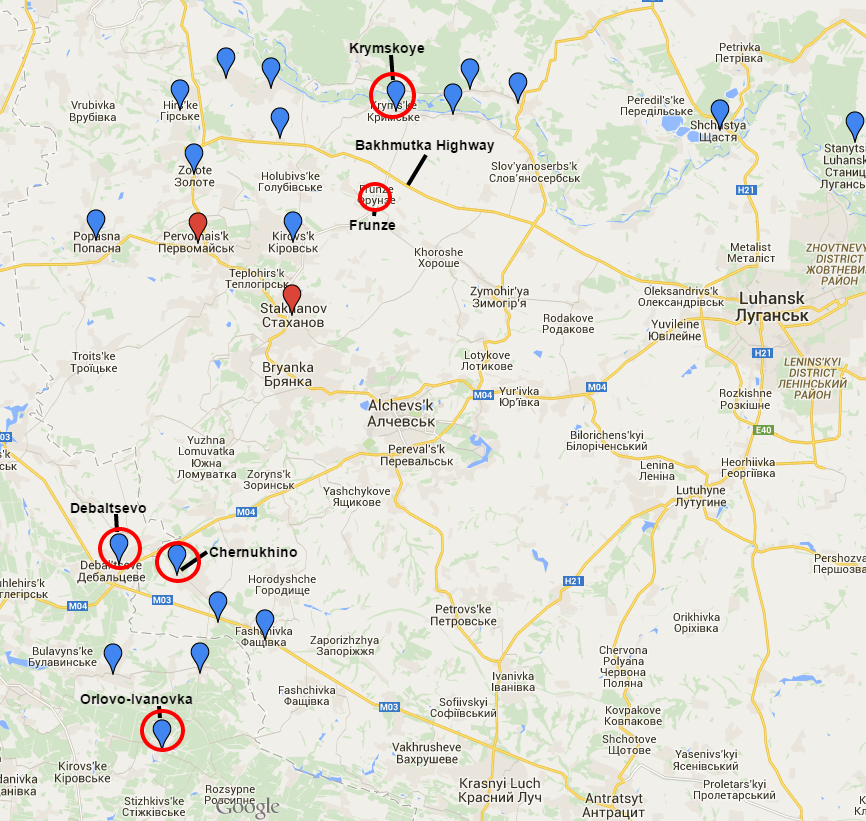Yesterday’s live coverage of the Ukraine conflict can be found here. An archive of our liveblogs can be found here. For an overview and analysis of this developing story see our latest podcast.
Please help The Interpreter to continue providing this valuable information service by making a donation towards our costs.
View Ukraine: April, 2014 in a larger map
For links to individual updates click on the timestamps.
For the latest summary of evidence surrounding the shooting down of flight MH17 see our separate article: Evidence Review: Who Shot Down MH17?
Anyone following our work today knows that the Russian ruble is in free fall. But Ukraine’s economy is also in trouble. In fact, the Ukrainian currency, the hryvnia, and the Russian ruble are the two worst-performing currencies of 2014.
But despite this coincidence, the ruble and the hryvnia are not falling for the same reasons. The easiest way to see this is in a chart. Here is the ruble’s performance this year (purple), and the hryvnia’s (blue), against the dollar.

What we see is that the hryvnia’s decline started earlier, and has fallen mostly by jumps. The fall of the Yanukovych government led to the first fall in February (though this fall was corrected when order was restored). The annexation of Crimea and the growth of Russian-backed separatism in the Donbass led to the large drops in March through April. The Russian invasion in August led to another major drop in value for the hryvnia. The more recent drops were due to the cumulative consequences of these problems — Ukraine’s GDP has been revised downward, and there are concerns that Ukraine may not meet the requirements of the next tranche of a loan from the International Monetary Fund (IMF) which has investors nervous.
But over the last month Ukraine’s currency has been flat at the exact time as Russia’s ruble has collapsed.
As of noon, eastern time, the ruble had lost 10.22% of its value against the dollar while the hryvnia was up .32%.
The fates of Ukraine and Russia are very much connected, and one could easily argue that the root cause of the collapse of both currencies is in fact the actions of Russian President Vladimir Putin. But the economic drivers affecting both currencies are very different, and so in this case, despite the coincidence, it may not be helpful to think about the ruble and the hryvnia at the same time.
But that does not mean that the Russian and Ukrainian economies do not effect each other. In fact, part of the decline of the ruble is the fact that its adventures in both Crimea and the Donbass will cost it a lot of money in both the short term and the foreseeable future. That makes statements made today by Russian Prime Minister Dmitry Medvedev that Russia “will no longer support the Ukraine economy” even more eyebrow raising:
He said Moscow had for many years provided generous terms in deals with Kiev which had helped build up Ukraine’s economy but the relationship would from now on be based on purely “rational and pragmatic” terms that put Russian interests first.
“We will no longer support the Ukrainian economy. It is a burden for us and to be honest, we are tired of it,” he wrote in Nezavisimaya Gazeta, a privately owned daily newspaper.
The article’s publication coincided with a visit to Brussels by Ukrainian Prime Minister Arseny Yatseniuk.
— James Miller
On Friday, December 12, Mark Feygin, a lawyer for Nadezhda Savchenko, a Ukrainian military officer who was captured by separatist fighters, illegally rendered to Russia, and is now facing charges for murder in Moscow, announced that his client was considering going on hunger strike if her case was not suspended in light of her status as a prisoner of war.
Today Interfax-Ukraine reports, citing Feygin, that Savchenko has indeed begun a hunger strike, though her lawyer reports that she has begun the strike due to the Russian authorities’ refusal to provide medical treatment, rather than for the reasons mentioned on Friday.
“Today, in Moscow City Court, Nadia, who participated [in the sitting] via video conferencing, announced a hunger strike, because she was denied a visit by an otolaryngologist,” Feygin said.
At the same time, another defense lawyer representing the pilot, Ilya Novikov, said that his client went on a hunger strike on Saturday, December 13. “In pre-trial detention center No.6 she is not allowed to see otolaryngologist and has not been given medicine purchased by her lawyers,” he explained.
According to Novikov, Savchenko has an inflammation of the ear, which started a week ago, and is getting worse. “She already can’t hear with her right ear,” Novikov said.
— Pierre Vaux
The “official site of the press centre of the government and people’s soviet of the Donetsk People’s Republic,” dnr.today, reports that Aleksandr Khodakovsky, the leader of the Vostok Battalion and the ‘secretary of the security council’ of the DNR, has said that there is “no point in capturing” Donetsk Airport.
While visiting students at a musical academy in Donetsk, Khodakovsky made two statements with regards to the conflict.
Firstly, he said that the boundaries of the self-proclaimed separatist state must match those of the whole Donetsk region.
The Interpreter translates:
“We must take the borders of the Donetsk region. If Ukraine does not agree to solve this issue by political means, we will settle it militarily.”
Khodakovsky then commented on the battle for control of Donetsk Airport:
“We have the forces to defend and maintain the city. But Donetsk Airport is more of a political point, therefore there is no sense in capturing it. A battle for it will only lead to the loss of fighters.”
Earlier today however, the Ukrainian military reported that there had been several attacks made on Ukrainian troops at the airport.
There is no shelling currently audible on the Ruptly live stream from Donetsk, suggesting that while attacks are still being made, the pre-ceasefire nightly shelling is, at least, still absent.
— Pierre Vaux
Novosti Donbassa reports that Serhiy Taruta, the former governor of the Donetsk region who was dismissed on October 10 this year, has told Ukraine’s 112 television channel that he has been informed that the ultra-nationalist Svoboda party has received funding from Russian interests and Andriy Kluyev, who was the head of Viktor Yanukovych’s Presidential Administration.
Kluyev is currently missing, wanted for participation in the mass killings during the attempted suppression of the Maidan protests. On February 28, the European Union, Austria, Switzerland and Lichtenstein froze his assets.
Taruta also named oligarch Ihor Kolomoyskyi, the governor of the Dniproetrovsk region, as a financial backer.

Taruta said that he had been informed by “participants in the political process” that Taruta and Kluyev had funded Svoboda as an “antidote” to the political power of Yulia Tymoshenko, whom they perceived as a threat to their interests.
Taruta said that “all those with whom the Yulia Tymoshenko Bloc was interfering naturally financed [Svoboda’s] creation. But this was in the initial stages.”
A video excerpt of the interview with Taruta is available here.
— Pierre Vaux
The independent Caucasian Knot reports that a 10th Russian ‘humanitarian convoy’ is being prepared in the Rostov region.
According to the report, the convoy is due to move in the next few days into eastern Ukraine.
Aleksandr Drobyshevsky, a spokesman for the Russian Emergencies Ministry, told the state-owned RIA Novosti news agency that trucks were bringing humanitarian aid from the Ural, Volga and North-Western federal districts to Rostov.
Cargo to be delivered includes food, construction materials and New Year gifts.
Caucasian Knot notes that the Ukrainian government has expressed concern about the formation of yet another convoy, saying that Ukrainian customs officials were not able to fully inspect the cargo of the previous convoy, and that documentation was missing.
Despite initial declarations when the first convoy was announced in August, none of the ‘humanitarian convoys’ have been conducted under the auspices of the Ukrainian authorities or the International Committee of the Red Cross, whose staff were, the Emergencies Ministry had claimed, to receive the cargo and to distribute it across the border.
The Ukrainian government considers the entrances of the convoys to be illegal violations of their territory.
The last convoy entered Ukraine on December 12 and reached the separatist-held cities of Donetsk and Lugansk.
— Pierre Vaux
Ukrainska Pravda reports that the ATO Press Centre has announced that Ukrainian military positions have come under fire seven times over the last 24 hours.
The announcement, made this morning at 5:15 GMT, said that attacks, conducted with both mortars and small arms, had been made near Frunze, Chernukhino, Olovo-Ivanovka and Donetsk Aiport.
The Interpreter translates:
“At Donetsk International Airport the bandits opened fire three times on the defenders of the airport from direction of the old terminal and the orthodox monastery,” says the announcement.
Taking advantage of the truce, ATO forces “are carrying out counter-sabotage measures and conducting operations to fight criminal activity in territories liberated from the occupiers.”

Ukrinform reports that the Ukrainian Ministry of Defence announced this morning that there had been “no losses” amongst Ukrainian security forces over the same time period.
Later, at 11:38 GMT, the ATO Press Centre announced that, over the course of the day so far, four violations of the ceasefire by Russian-backed fighters had been recorded. These included the use of Grad rockets and artillery.
According to the report, Russian-backed forces shelled Ukrainian positions near Krymskoye, Debaltsevo and Chernukhino.
The press centre said that Ukrainian forces had returned artillery fire.
Here is a map of the reported attacks near Debaltsevo and the Bakhmutka highway:

— Pierre Vaux